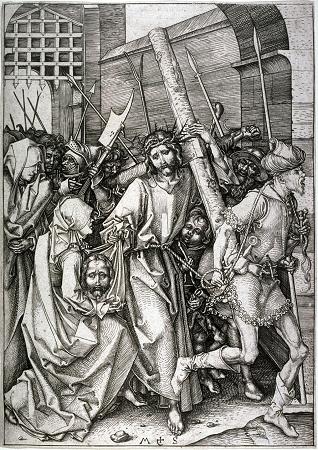Martin Schongauer (c1442 - 1491). Martin Schongauer, also known as Martin Schön or Hübsch Martin by his contemporaries, was an Alsatian engraver and painter. He was the most important printmaker north of the Alps before Albrecht Dürer, who collected his work. He is the first painter to be a significant engraver, although he seems to have had the family background and training in goldsmithing which was usual for early engravers. The bulk of Schongauer's surviving production is 116 engravings, all with his monogram but none dated, which were well known not only in Germany, but also in Italy and even made their way to England and Spain. Vasari says that Michelangelo copied one of his engravings, in the Trial of Saint Anthony. His style shows no trace of Italian influence, but a very clear and organised Gothic, which draws from both German and Early Netherlandish painting. Recent scholarship, building on the work of Max Lehrs, attributes 116 engravings to him, with many also being copied by other artists, as was common in the period. His prolific contemporary Israhel van Meckenem did close copies of 58 engravings, exactly half of Schongauer's output, and took motifs or figures from more, as well as apparently engraving some drawings that are now lost. There are some fine drawings, including ones dated and signed with his monogram, and a surviving few paintings in oil and fresco. Schongauer was born about 1450-53 in Colmar, Alsace, the third of four or five sons of Caspar Schongauer, a goldsmith and patrician from Augsburg who moved to Colmar about 1440; Caspar became a master of the goldsmith's guild in 1445, which probably required a residence of five years. He presumably taught his son the art of engraving, which is a distinct and difficult skill that goldsmiths had long used on metal vessels. Two of his brothers worked as goldsmiths in Colmar, while another also became a painter. Colmar is now in France but was then part of the Holy Roman Empire and German-speaking. Most unusually for a Gothic or Renaissance artist, he was sent to university, presumably with the intention of turning him into a priest or lawyer, and matriculated at the University of Leipzig in 1465, but seems to have left after a year. At this time university students often began at the age of twelve or thirteen. He was traditionally thought to have been trained as an engraver by Master E. S., but scholars now doubt this, partly because Schongauer's prints took some time to develop the technical advances that a pupil of Master E. S. would have been taught. He is thought to have trained as a painter with Colmar's main local master Caspar Isenmann, a neighbour of his parents, who was greatly influenced by the Early Netherlandish painting of Rogier van der Weyden and others, and had perhaps studied in the Netherlands, and Schongauer's few surviving pictures reflect this. This was probably around 1466 and 1469; he was recorded as back in Colmar in 1469. His older brother Ludwig Schongauer had probably preceded him in the workshop. His earlier engravings also show clear influences from several Early Netherlandish painters, suggesting that he followed the traditional pattern of a wanderjahre travelling at the end of his training. One drawing, dated 1469, is a copy of the figure of Christ in Rogier van der Weyden's Beaune Altarpiece, presumably made in front of the painting. Various details of costume, and the exotic plants in the Rest on the Flight into Egypt, have suggested to some scholars that he also visited Spain, and possibly Portugal. He returned to Colmar and had established a workshop by 1471, when payments were made for an altarpiece for the Dominican church there, which is now in the museum and regarded as a workshop production. His Madonna in the Rose Garden, long displayed in the church in Colmar it was made for, but moved to the Dominican church nearby in 1973, is dated 1473. Its style corresponds with the earliest of his engravings, which have been placed in a broadly agreed sequence based on their technique and style, both of which show considerable development. In some cases a terminus ante quem is provided by copies in various media that can be dated. The economics of fifteenth-century printmaking are unclear, and though his prints spread his fame widely across Europe, he may have relied more on the income from his major vocation of painting. He died in Breisach in 1491, perhaps before reaching the age of forty. He had been engaged since 1488 in painting a large Last Judgment in the cathedral there, and was recorded as a citizen there in June 1489. This was the largest mural painting north of the Alps, and was incomplete at his death. The following year Dürer, on his wanderjahre, travelled to Colmar not meet him, only to find he had died.
more...










